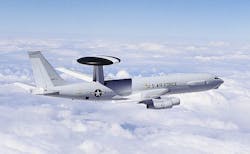Boeing moves forward with project to install digital electronics in E-3 Sentry cockpit avionics
Officials of the Air Force Life Cycle Management Center at Hanscom Air Force Base, Mass., are asking the Boeing Defense, Space & Security segment in Oklahoma City to continue work on the E-3 Airborne Warning and Control System (AWACS) Diminishing Manufacturing Sources Replacement of Avionics for Global Operations and Navigation (DRAGON) program.
AWACS DRAGON seeks to modernize the E-3's cockpit by replacing most analog indicators with modern digital multicolor graphic displays. Nearly all of the 1970s-vintage avionics are being replaced with updated subsystems that comply with today's air traffic management standards.
This update also will eliminate the E-3's the navigator, dropping the crew size from four to three, as well as add a Mode-5 identification friend-or-foe (IFF) capability.
Thursday's order is a modification to a June 2017 $13.1 million contract for low-rate initial production (LRIP) of the AWACS DRAGON program, and awards the remaining effort not associated with the program's LRIP phase.
Related: Air Force orders AWACS flight simulators to help pilots train on upgraded cockpit avionics
The original contract awarded last summer called for Boeing to install AWACS DRAGON Group A mod kits, Group B mod kits, and software aboard AWACS aircraft. The Air Force operates 32 E-3 aircraft, and NATO operates 16.
The plane is a modified four-engine Boeing 707 passenger jet that provides all-weather surveillance, command, control, and communications.
AWACS DRAGON leaves the E-3's systems like engines, airframe, and mission systems intact, yet upgrades the plane's flight deck with new technology used by the commercial airline industry.
The effort includes digital satellite communications (SATCOM); modern flight management system; and digital cockpit with five glass display screens for engine, navigation and situational awareness data. It also includes weather radar that can predict wind shear; enhanced ground proximity warning system; and digital flight deck audio distribution system.
On this order Boeing will do the work in Oklahoma City, and should be finished by January 2022. For more information contact Boeing Defense, Space & Security online at www.boeing.com/company/about-bds, or the Air Force Life Cycle Management Center at www.wpafb.af.mil/aflcmc.
Ready to make a purchase? Search the Military & Aerospace Electronics Buyer's Guide for companies, new products, press releases, and videos

